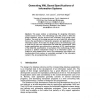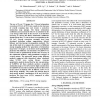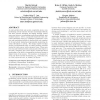10802 search results - page 71 / 2161 » Generative and developmental systems |
COMSIS
2004
13 years 7 months ago
2004
This paper outlines a methodology for designing information systems based on XML. The methodology uses XML DTDs to define the design standards, and the structure and constraints of...
ISBI
2008
IEEE
14 years 2 months ago
2008
IEEE
The use of X-ray CT images for CT-based attenuation correction (CTAC) of PET data results in the decrease of overall scanning time and creates a noise-free attenuation map (μmap)...
CF
2005
ACM
13 years 10 months ago
2005
ACM
As microarchitectural and system complexity grows, comprehending system behavior becomes increasingly difficult, and often requires obtaining and sifting through voluminous event ...
FLAIRS
2003
13 years 9 months ago
2003
The goal of our work is to improve the Natural Language feedback provided by Intelligent Tutoring Systems. In this paper, we discuss how to make the content presented by one such ...
ENGL
2007
13 years 7 months ago
2007
— In any information system, the reducts are useful in classifying data. Janusz Starzyk developed an algorithm for computing reducts using strong equivalence and the law of expan...



